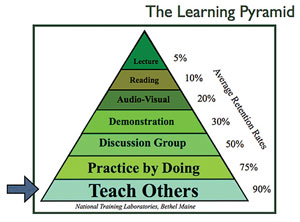
Fast forward to today in plants all around the world, where there are people of nearly all ages huddled in classrooms and around PCs in an effort to learn how to prevent fire. Yes, I am talking about gas detection training.
From trial and error to training
Electric gas monitors have been around for decades, and became mass produced and gained popularity in the 1970s. When gas monitors were sold, typically the only way a user could learn how to use it would be to read an owner’s manual and then learn by trial and error in the field. The equipment was generally light on features, heavy in size and weight, and unreliable. Operators would have to learn idiosyncrasies about the devices on their own or through the experiences of others and by word-of-mouth. While this was not the safest way to approach the use of a gas detector, in some small way, social learning in gas detection was born.
As electronic gas monitors grew in popularity, the size of the actual devices got smaller. Features were added to make them more like commercially available products. The monitors became more reliable and more widely distributed. Because of this, learning had to be approached differently. More gas monitors means that more people have to be competent on the use of them in order to maintain a safe work environment. To satisfy this need, we need a balanced training approach while taking into account the fact that learning needs change from one person to another.
Match methods to your needs
In today’s world, there are many mediums through which people learn: books, magazines, lectures, videos, CDs, CD-ROM, online tutorials, mentorships, manuals, etc. Each of these provides a solid foundation depending on the needs of the student. For most, an instructor-led class still works best. The instructor needs to be an expert in the field of gas monitoring, as well as experienced and skilled on the use of the product(s). Live, instructor-led classes should be varied based on the audience and desired educational outcome.
For example, you would not want to send an Operator to a Technician class. Understanding how to troubleshoot and repair an instrument will not have much value if the basic operational aspects are not communicated. When searching for live, instructor-led classes that will best suit your educational needs, read the course syllabus and look for subjects that are most applicable to you, such as operations, technician, confined space entry and occupational safety. Choosing a class that is the best fit for you will ensure a positive learning experience in which you retain the information for later application.
Action aids retention
Additionally, live, instructor-led classes should have a good balance including lectures, multi-media graphics, hands-on activities, and class participation in the form of practical exercises. These varying aspects ensure that the student remains engaged from the beginning to the end of the class. The most important of these elements are the hands-on exercises and practical exercises that require class participation. Getting students involved is the best way to make sure they are retaining what you are teaching.
Keep in mind that studies say that most adults retain information for a longer period of time and to a greater percentage by actually doing what they are learning. According to the National Training Laboratory’s “Learning Pyramid,” adults retain just 5 percent of what they learn from a lecture alone, but that percentage increases to 30 percent by demonstrating what they learned. Ultimately, learning is retained a full 90 percent when the student practices by teaching others.
Web-based benefits
With the Digital Age, instructor-led classes can now be delivered over the Web. This involves a Web hosting software service and a phone line. Students at one end of the session log onto the Web hosting software site, dial a phone number, and are connected to the instructor at the other end. Live, Web-based training sessions deliver the same impact as an on-site program, only the instructor does not have to travel to your facility. More important, if you have multiple facilities, your employees do not have to travel, which eliminates high travel costs.
Archiving training for future use is also a cost-saver. In most cases, online training modules can be archived and posted to the Internet so that students can access them any day at any time. These online training tutorials mimic the live sessions and are recorded for easy recall. Because these training programs are hosted on the Web, access is all that is required to open the student up to unlimited learning opportunities. With any recorded training medium, the student should have access to the device they are learning about so that they can create their own hands-on experience.
Educational diversity
When it comes to training, each person is different and a one-size-fits-all approach often is ineffective. Understanding students’ needs on an individual basis — and seeking tools to fit them and their situation — is key. The main driver for this educational diversity is your desire to eliminate accidents and injuries in every situation and promote safety throughout your organization at all times.
When your business mandates that humans work in potentially hazardous environments, the stakes are too high to have uneducated, untrained employees conducting the work. Today, there are many training options designed to provide workers the tools needed to ensure they go home safely at the end of their shift. Take advantage of the many leading training programs available to help keep workers safe.

